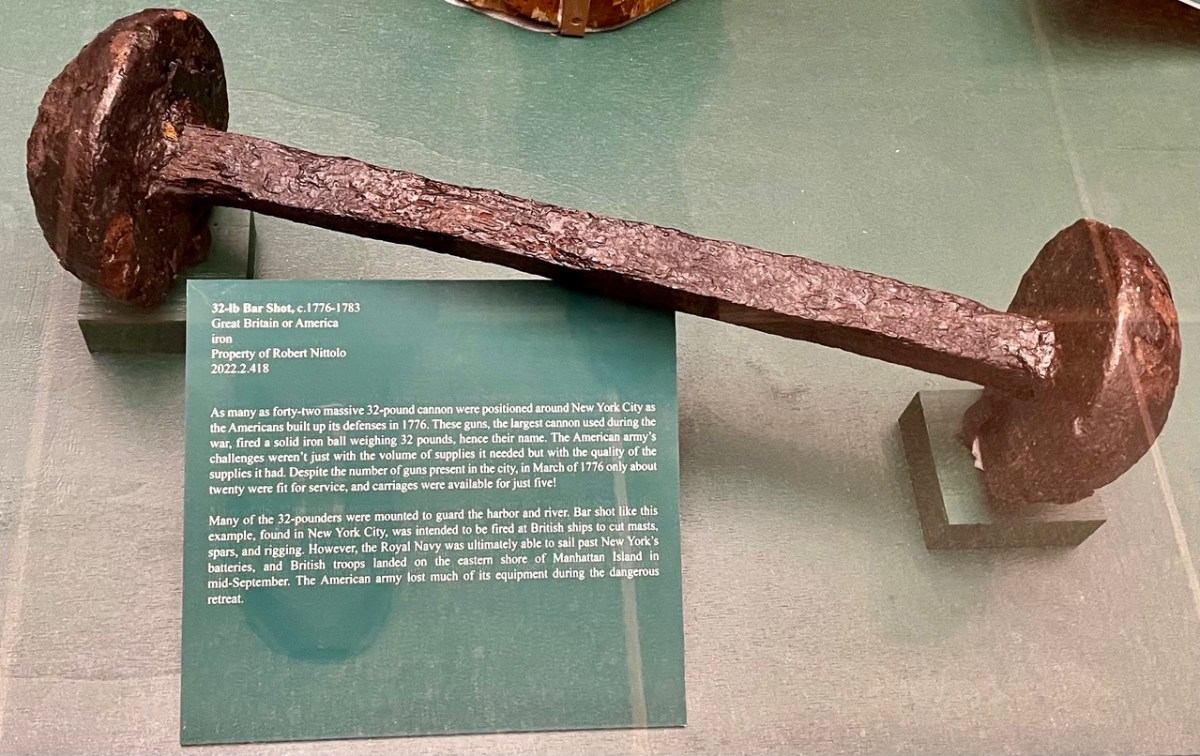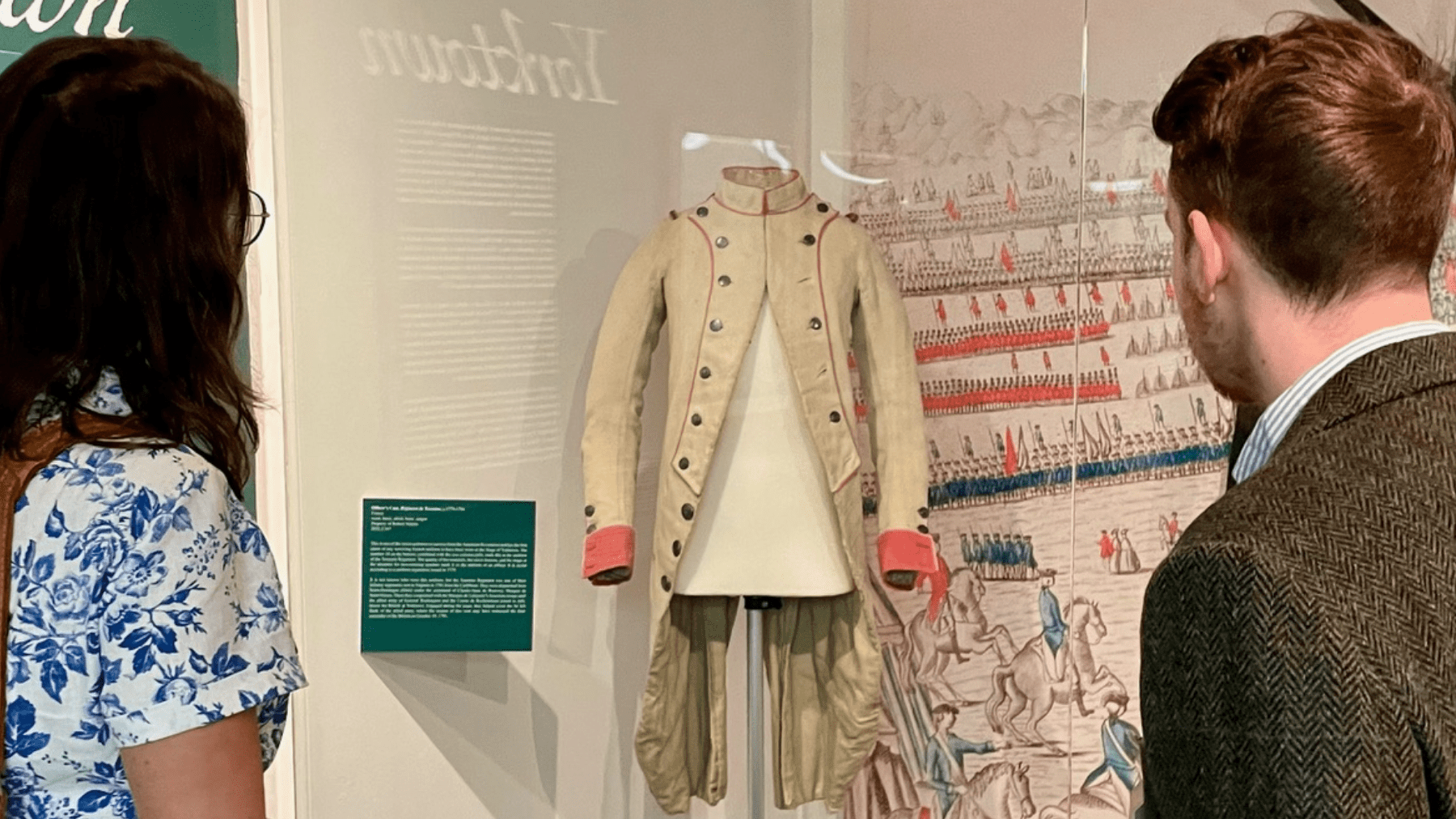Hannah Lawrence fell into the rarest of demographics: a bellicose Quaker. “She was a New York City Quaker who was ardently pro-American as the Revolutionary War broke out, which is interesting because Quakers, of course, are a pacifist sect,” said Matt Keagle, curator at Fort Ticonderoga on Lake Champlain. “She was a poet, and wrote these poems that expressed her support for the American war effort, the heroism of General Montgomery at Quebec and all of these things.”
Meanwhile, in the fort’s collection of artifacts were a uniform coat and a copy of a portrait of a dashing British officer named Jacob Schieffelin, a successful businessman from Montreal who had fought to repulse the colonist Ethan Allen’s ill-fated invasion of Canada.
In 1780, the passionate loyalist Jacob found himself temporarily billeted in the family home of the passionate colonist Hannah, and anyone who can’t figure out what happened next needs to sign up for a remedial course in Fairy Tale 101.
The two philosophical adversaries were secretly wed several weeks later, and went on to a life of great wealth and success, eventually building an estate north of what was then New York City in a rural countryside that came to be called Manhattanville, with streets laid out by Schieffelin and named for his and the Lawrence families, as well as for their new friend and neighbor Alexander Hamilton.
Wedding jewelry reunites Revolutionary couple’s story
It was a story Keagle knew well, so as he was sifting through the 3,000 artifacts in the collection of the late New Jersey insurance-claims investigator Robert Nittolo, he was stopped short by three pieces of jewelry, with an engraving on the back: Hannah Schieffelin, 1780.
“It was probably her wedding jewelry,” Keagle said. “And so (together with the coat and portrait) to be able to bring this grouping of objects together to tell a story, not just of Hannah, not just of Jacob, but of their collected experience during the Revolution, that puts additionally a very human face on a couple like this.”
In August, Fort Ticonderoga announced that it had raised the $12 million needed to purchase the Nittolo collection, a coveted high-quality assemblage of artifacts procured over the course of a lifetime.
“This is transformative for Fort Ticonderoga,” said the fort’s President and CEO Beth Hill. “The acquisition of the Robert Nittolo Collection is an extraordinary achievement that not only preserves these irreplaceable artifacts but also allows us to tell the story of our nation’s founding in a way that has never been possible before.”
The collection is of such impact that it will drive exhibitions and other programming in the coming years, Hill said, “ensuring that the lessons of our past are accessible and relevant to future generations.”
Some of the artifacts are already on display as part of the fort’s new exhibit, “A Revolutionary Anthology,” connecting personal stories of the era to political and societal shifts. The full collection will be integrated into the museum’s programming in the coming years.
Keagle said that talks with Nittolo about the future of the collection went on for about a decade, as he fielded inquiries from multiple institutions in the U.S. and abroad. Nittolo passed away during the negotiations, but by then he had decided he wanted the collection to go to the place that had inspired him as a boy—Fort Ticonderoga.
“It’s especially meaningful because you simply couldn’t build a collection of this kind today,” Keagle said. “Material from this time period is so rare that it would be impossible.”

 Bar shot used with limited success by Americans to rip apart masts and rigging of British ships. Photo by Tim Rowland
Bar shot used with limited success by Americans to rip apart masts and rigging of British ships. Photo by Tim Rowland
60 years of purposeful collecting yields cohesive collection
Nittolo collected over the course of 60 years, purposefully targeting artifacts with meaning rather than random relics. He would buy collections to gain one particular piece, then sell off what he was not interested in, Keagle said.
As such, the cohesiveness made it imperative the collection be kept whole rather than, as is more typical, auctioned off and scattered to the four winds.
“This grouping of objects together represents almost the exact complement to Fort Ticonderoga,” Keagle said. “This existing collection of artifacts that document the early modern military experience was significant enough and large enough that it was, just vital for us to jump on this and keep it together.”
For years, Keagle was in constant touch with Nittolo, and paid numerous visits to his unassuming New Jersey home. The experience was a bit surreal, seeing a museum’s worth of high-quality pieces in a small household space.
” It was overwhelming,” he said. “You would walk through and say, ‘Oh, look at this. Look at this musket right here.’ And I pull up this musket, and then there’s two dozen next to them, all equally as interesting and historically significant and compelling.”
Artifacts traced to specific battles return home
Ireland, for example, was part of the British Empire in the 18th century, but still maintained its own parliament, military and weapons foundries. An Irish rifle was supplied to the 53rd Regiment of Foot in the colonies, and issued to a soldier who participated in Gen. John Burgoyne’s 1777 invasion into New York from Canada.
Garrisoned at Fort Ticonderoga, they fell victim to an American raid in September 1777, and the gun fell into colonial hands. “Not only can we trace this weapon back to the Revolutionary War and service here, but quite literally to the day it was taken from these soldiers and its subsequent use” by the Continentals. Now, nearly 250 years later, it’s back.
The collection is also notable in that Nittolo, unlike many collectors, didn’t focus on just muskets, or just swords. He hunted down anything that would tell a story. There’s the French coat, perhaps the only surviving one worn by a soldier who witnessed Cornwallis’ surrender in Yorktown. There is a Hanoverian officer’s sash, which would be weird except that, largely forgotten, is that King George at that time ruled the small electorate of Hanover in Germany.
These stories, Keagle hopes, will inspire other young people to become fascinated by history, just as Nittolo was so many years ago.
“In the 1950s, his parents took him to Fort Ticonderoga, and it was that visit that really spurred his interest in the colonial and the Revolutionary period, and kick started his collecting that led to this incredible collection,” Keagle said. “And so it was very apt and very fitting that it should go to Fort Ticonderoga, where this place and this story had inspired him so much.”

